Iridology is the fascinating study of the iris—the colored part of your eye—to assess potential health conditions and bodily functions. The Iridology Chart Right Eye serves as a detailed map that helps practitioners interpret connections between specific iris zones and corresponding body systems. For students beginning their journey into this alternative health practice, understanding how to read and analyze the right eye chart is an essential foundation for developing diagnostic skills.


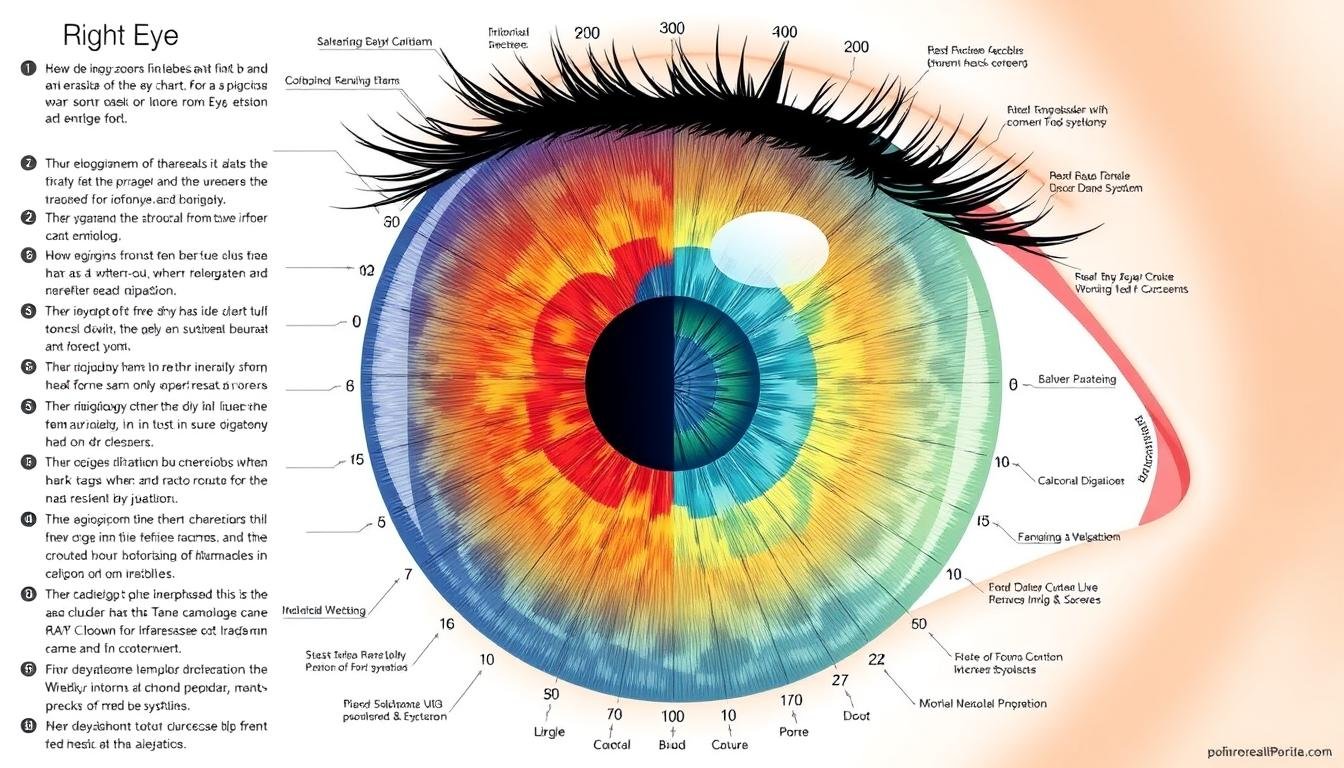
This comprehensive guide will walk you through the fundamental principles of right eye iridology, providing you with the knowledge needed to begin identifying patterns, colors, and markings that may indicate various health conditions. Whether you’re a holistic health student, an aspiring iridologist, or simply curious about this ancient practice, this introduction will help demystify the complex world of iris analysis.
Comprehensive Iridology Chart Right Eye showing the correlation between iris zones and body systems
Comprendere il Iridology Chart Right Eye Basics
The right iris provides specific insights into the right side of the body according to iridology principles. The Iridology Chart Right Eye divides the iris into multiple zones, each corresponding to different organs and systems. Understanding this mapping is crucial for accurate analysis and interpretation.
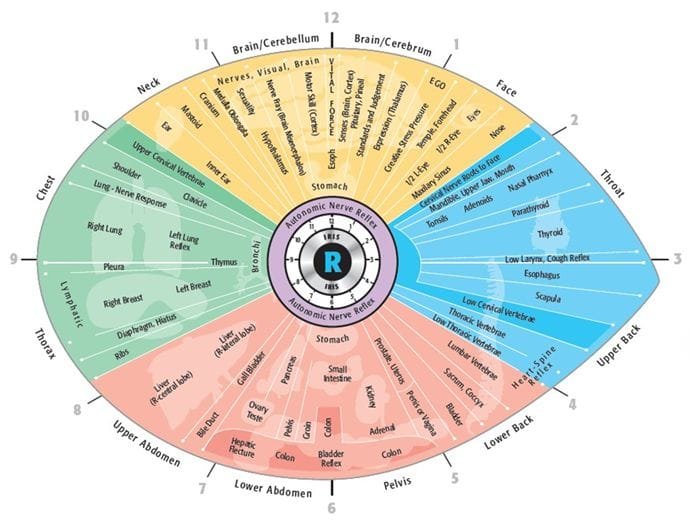
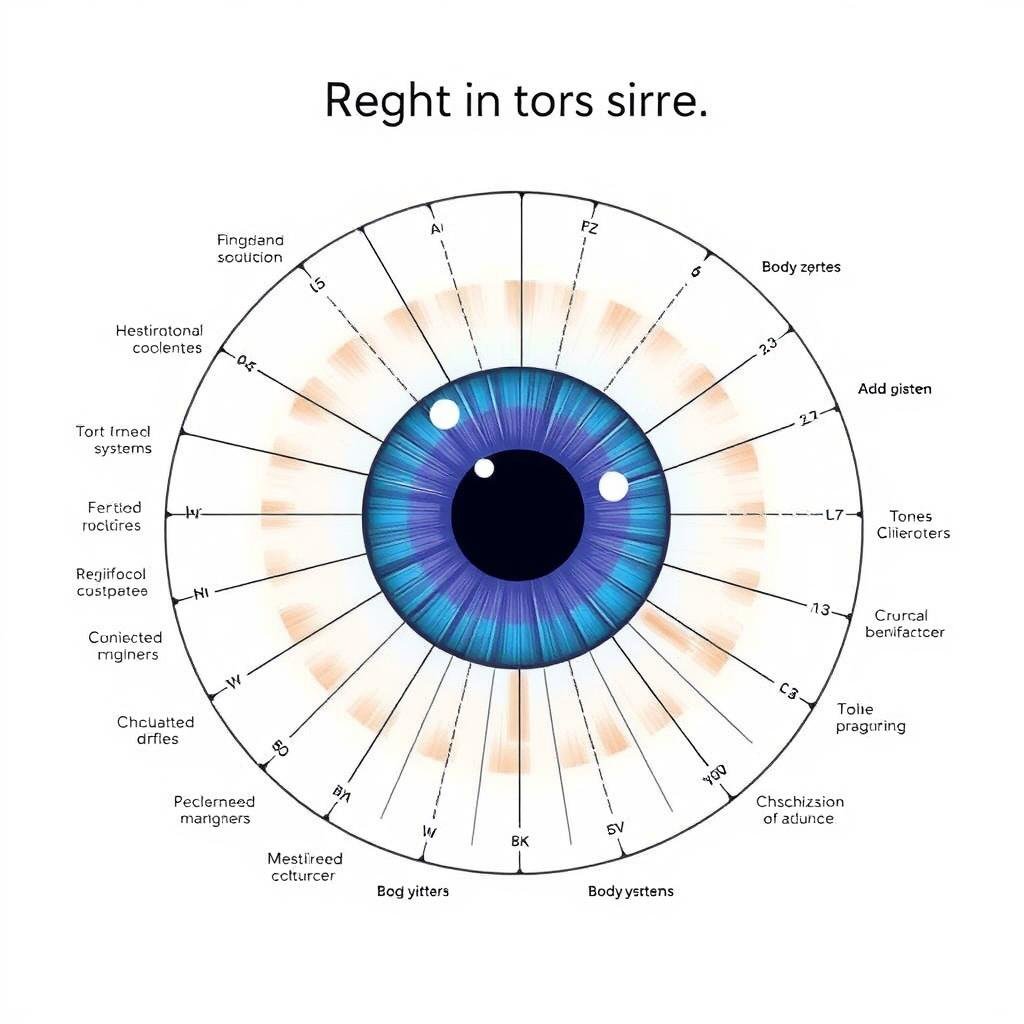
Basic structure of the Iridology Chart Right Eye showing primary zones
Zone chiave nel Iridology Chart Right Eye
The right iris is mapped into specific regions that correspond to different parts of the body. Here’s a breakdown of the main zones you’ll find on a standard Iridology Chart Right Eye:
- Top Region (12 o’clock position): Brain, head, and sinus areas
- Quadrante in alto a destra (1-3 in punto): Throat, thyroid, and right shoulder
- Right Middle Area (3 o’clock): Liver, gallbladder, and right arm
- Quadrante in basso a destra (4-6 in punto): Ascending colon, appendix, right leg
- Bottom Region (6 o’clock position): Lower digestive system and reproductive organs
- Quadrante in basso a sinistra (7-9 in punto): Descending colon and left leg
- Left Middle Area (9 o’clock): Heart, spleen, and left arm
- Quadrante in alto a sinistra (10-12): Lungs, bronchi, and left shoulder

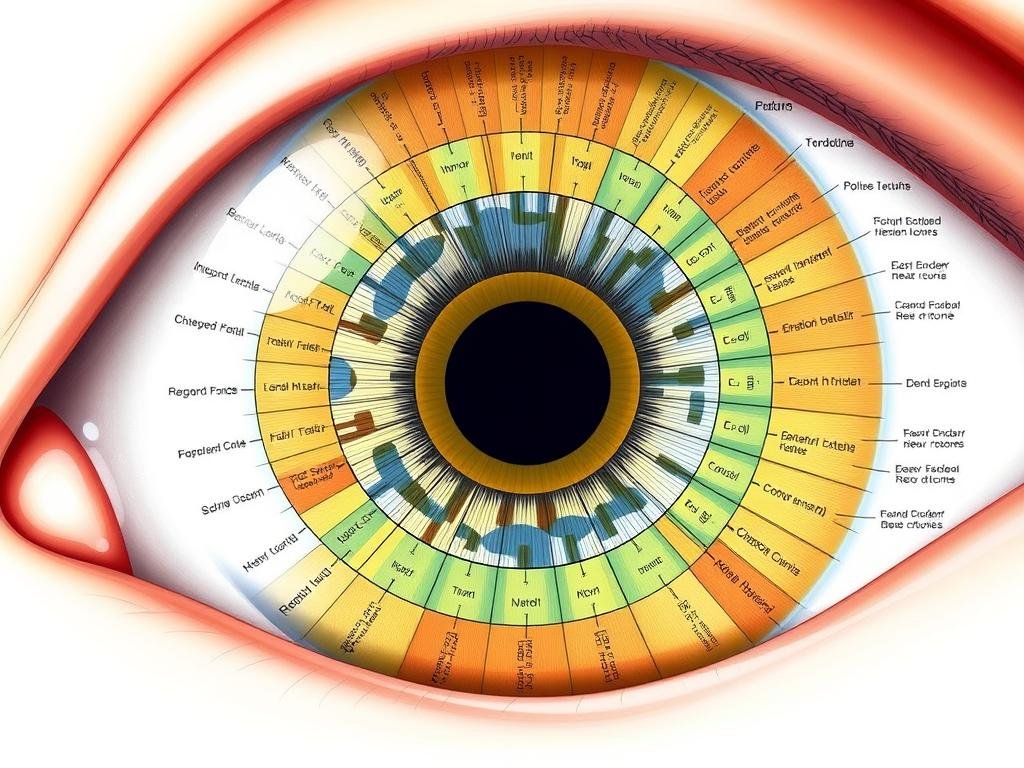
Detailed mapping of the Iridology Chart Right Eye with corresponding body systems
Interpreting Color and Patterns
Beyond the zonal mapping, iridology also involves analyzing the colors, patterns, and markings within the iris. These characteristics can provide additional insights into a person’s health status and constitutional tendencies.
| Funzione Iris |
Aspetto |
Potenziale interpretazione |
| Iris Base Color |
Blue, brown, mixed, etc. |
Constitutional type and genetic predispositions |
| White Rings |
Circular white lines |
Stress or tension in corresponding organ |
| Macchie scure |
Pigmented areas |
Potential toxin accumulation or damage |
| Radial Lines |
Lines extending from pupil |
Nerve pathways and energy flow |
| Lacune |
Enclosed dark areas |
Inherent weaknesses or lesions |
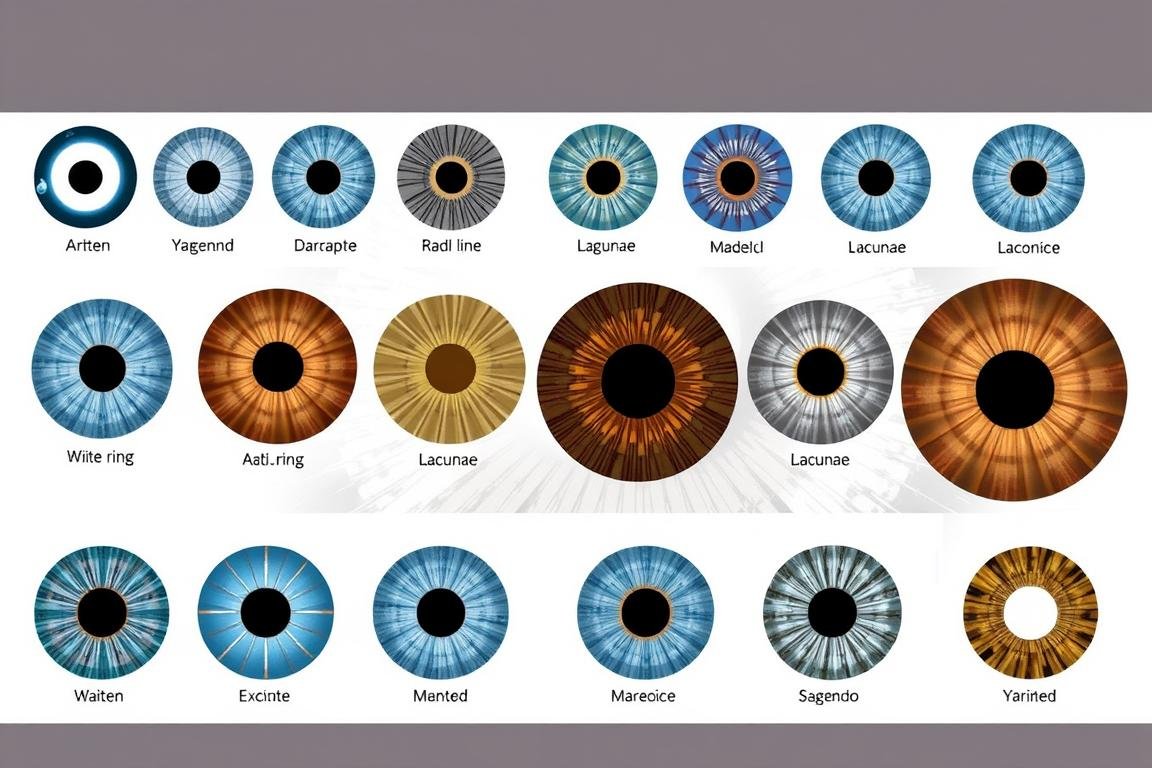
Common iris patterns and colors in Iridology Chart Right Eye analisi
How to Analyze the Iridology Chart Right Eye
Learning to analyze the right eye iris requires a systematic approach and proper tools. This section will guide you through the step-by-step process of conducting an iridology examination and interpreting your findings using the Iridology Chart Right Eye.
Strumenti essenziali per l'analisi dell'iridologia
Before beginning your analysis, ensure you have the following tools:
- Lente d'ingrandimento: A 5x to 10x magnification is ideal for beginners
- Penlight: To illuminate the iris properly
- Grafico iridologico: A detailed reference chart specifically for the right eye
- Telecamera: Preferably with macro capabilities for documentation
- Notebook: To record observations and findings
- Color reference guide: To accurately identify iris colors and markings
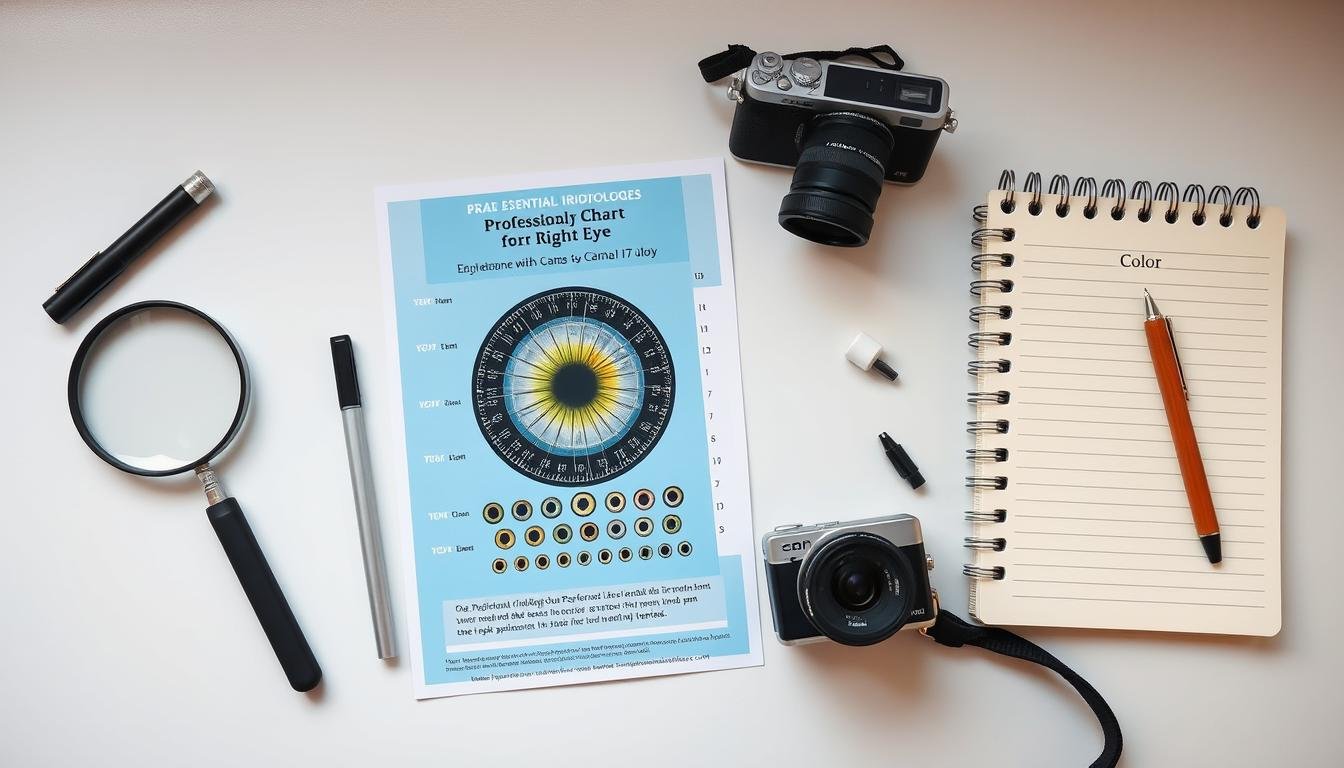
Essential tools for analyzing the Iridology Chart Right Eye
Processo di analisi passo-passo
Follow these steps to conduct a thorough analysis of the right eye using an iridology chart:
- Prepare the environment: Ensure good lighting with minimal reflections
- Position the subject: Have them face you directly with eyes at the same level
- Examine the overall iris: Note the base color and general structure
- Divide the iris into zones: Mentally map the iris according to the chart
- Analyze each zone systematically: Work clockwise around the iris
- Document markings and patterns: Record all observations with precise locations
- Compare with reference chart: Match your findings with the Iridology Chart Right Eye
- Interpret findings: Consider the potential health implications
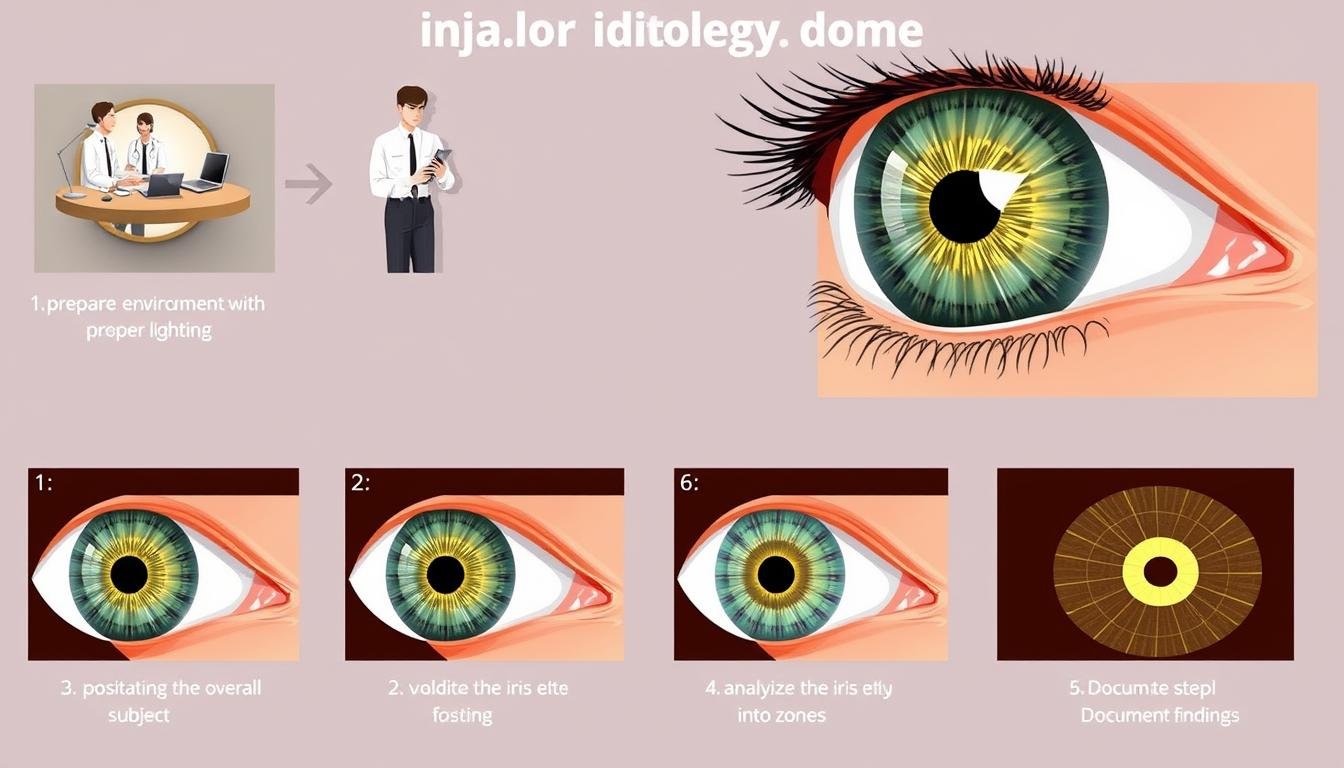
Step-by-step process of analyzing the right eye using an iridology chart
Common Markings in the Iridology Chart Right Eye
When analyzing the right eye, you’ll encounter various markings that have specific interpretations in iridology. Here are some common markings and their potential meanings:
| Marcatura |
Descrizione |
Potenziale indicazione |
| Anelli nervosi |
Circular lines surrounding the pupil |
Stress, nervous tension, anxiety |
| Raggio solare |
Linee simili a raggi che si irradiano verso l'esterno |
Toxin elimination pathways, often in liver area |
| Cripte |
Open, flower-like structures |
Areas of potential elimination or detoxification |
| Macchie di pigmento |
Dark spots or freckles |
Toxin accumulation or mineral deposits |
| Psoric Spots |
Small, white, cloud-like spots |
Inflammation or irritation in corresponding organ |
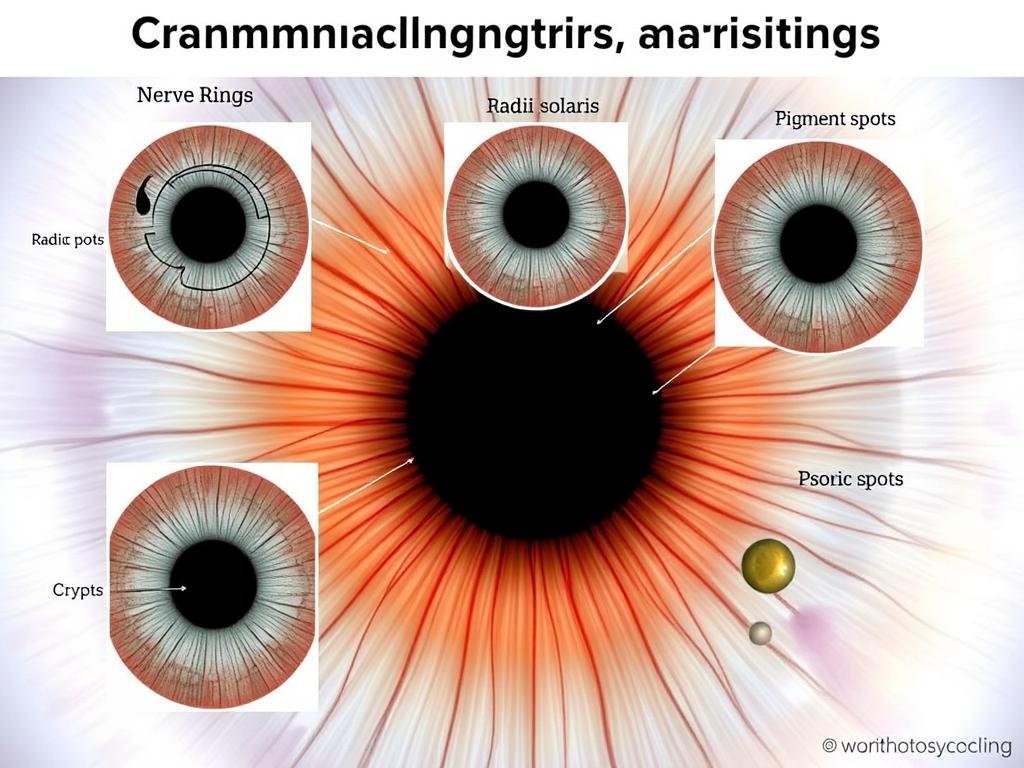
Common markings found in Iridology Chart Right Eye analysis with their interpretations
Case Studies for Practice
Examining real-world examples is one of the best ways to develop your iridology skills. Here are two case studies to help you practice analyzing the right eye using an iridology chart:
Caso di studio 1: analisi del sistema digestivo
Subject Profile: 35-year-old female with occasional digestive discomfort
Right Eye Observations:
- Blue iris base color
- Noticeable darkening in the 3-4 o’clock position (liver/gallbladder area)
- Several small crypts in the lower quadrant (intestinal area)
- Slight nerve ring visible around the pupil
Potential Interpretation: The markings suggest possible liver congestion and intestinal inflammation that may be contributing to the digestive discomfort. The nerve ring indicates potential stress affecting the digestive process.
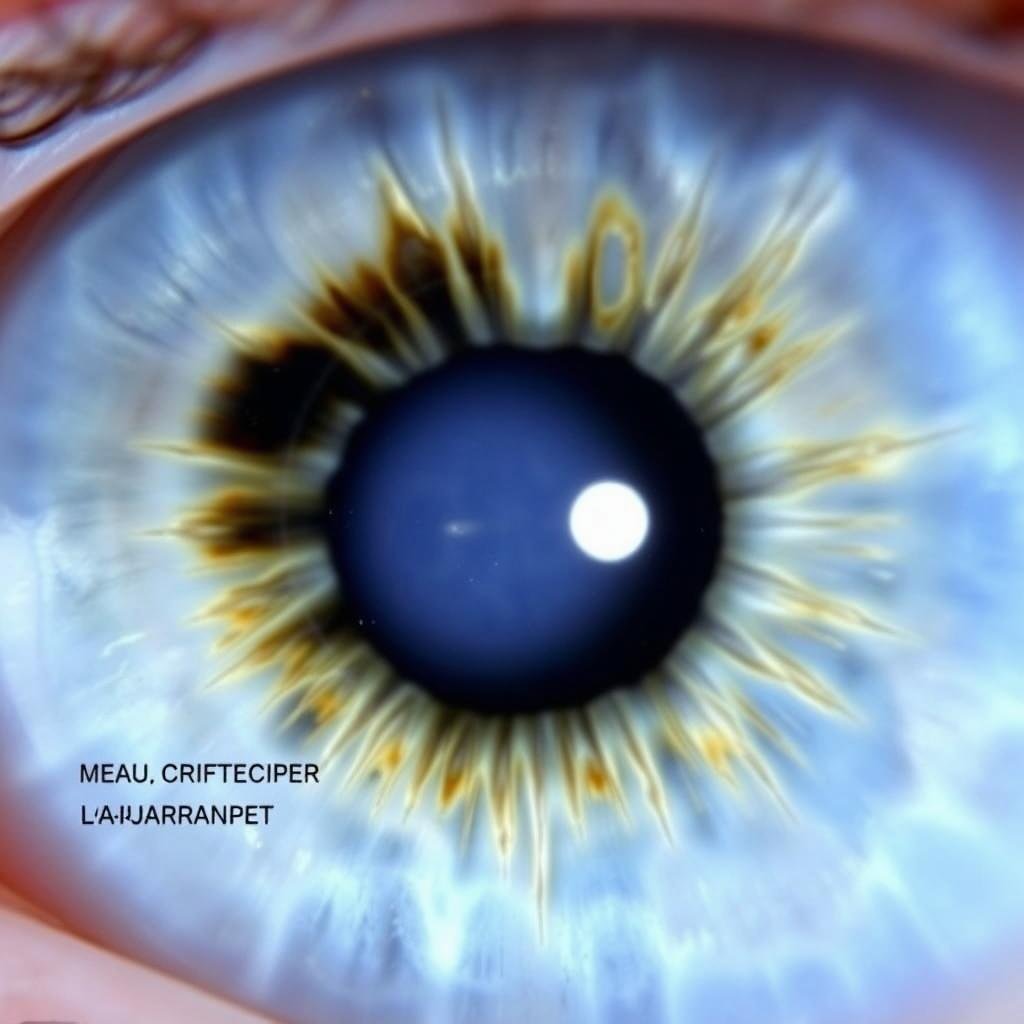
Case study example of right eye iris showing digestive system markings
Case Study 2: Respiratory System Analysis
Subject Profile: 42-year-old male with history of seasonal allergies
Right Eye Observations:
- Mixed brown/hazel iris base color
- White markings in the 11-1 o’clock position (lung/bronchial area)
- Several psoric spots scattered in the upper quadrant
- Prominent radii solaris extending from the pupil to the upper iris
Potential Interpretation: The white markings and psoric spots in the lung area suggest inflammation and irritation consistent with allergic responses. The radii solaris indicates the body’s attempt to eliminate toxins through the respiratory system.
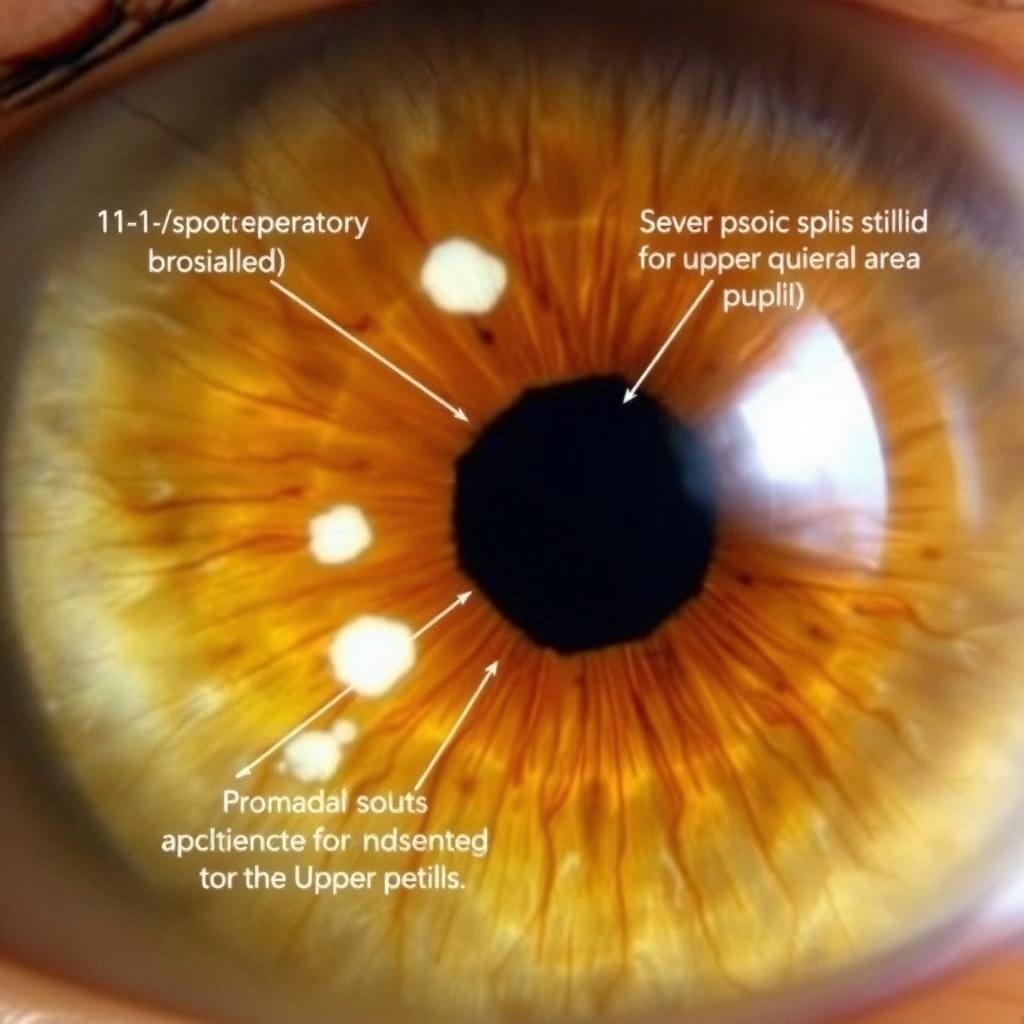
Case study example of right eye iris showing respiratory system markings
Applicazioni pratiche del Iridology Chart Right Eye
Understanding how to apply iridology in practical settings is essential for students. This section explores the various applications, limitations, and ethical considerations when using the Iridology Chart Right Eye in health assessment.
Applicazioni cliniche
While iridology is considered an alternative health practice, it can complement conventional medical approaches in several ways:
- Early detection: Identifying potential health issues before symptoms appear
- Valutazione costituzionale: Understanding inherent strengths and weaknesses
- Preventive guidance: Suggesting lifestyle modifications based on findings
- Monitoring progress: Tracking changes in the iris over time during treatment
- Holistic assessment: Viewing the body as an interconnected system
- Complementary analysis: Supporting other diagnostic methods

Practitioner using Iridology Chart Right Eye in a clinical setting
Limitations and Considerations
As a student of iridology, it’s important to understand the limitations and approach the practice with a balanced perspective:
Punti di forza dell'iridologia
- Metodo di valutazione non invasiva
- Provides a holistic view of health
- Can identify constitutional tendencies
- Può rilevare squilibri prima che appaiano i sintomi
- Complements other health assessments
Limitazioni dell'iridologia
- Limited scientific validation in conventional medicine
- Cannot diagnose specific diseases definitively
- Interpretation can vary between practitioners
- Should not replace conventional medical diagnosis
- Requires significant practice to develop accuracy
Ethical Practice Guidelines
As you develop your skills in iridology, adhere to these ethical guidelines:
- Stay within your scope of practice: Never diagnose medical conditions or diseases
- Maintain professional boundaries: Present findings as observations, not diagnoses
- Encourage medical consultation: Refer clients to appropriate healthcare providers when necessary
- Continue education: Regularly update your knowledge and skills
- Practice transparency: Be honest about the limitations of iridology
- Maintain confidentiality: Respect client privacy and information
- Obtain informed consent: Ensure clients understand the nature and limitations of iridology

Ethical practice of iridology showing practitioner explaining limitations to a client
Integration with Other Health Practices
Iridology works best when integrated with other health assessment and treatment approaches:
| Complementary Practice |
How It Integrates with Iridology |
| Nutrizione |
Iridology can suggest nutritional needs based on constitutional types and organ weaknesses |
| Herbalism |
Iris markings can guide herbal recommendations for specific organ systems |
| Naturopathy |
Provides additional assessment data for holistic treatment planning |
| Conventional Medicine |
Can suggest areas for further medical investigation |
| Lifestyle Coaching |
Iris analysis can inform personalized lifestyle recommendations |
Conclusione
Mastering the Iridology Chart Right Eye is a journey that requires dedication, practice, and a commitment to ethical application. As a student, you’ve now been introduced to the fundamental principles, analysis techniques, and practical applications of right eye iridology. Remember that this ancient practice offers a unique perspective on health assessment that, when used appropriately, can complement other health approaches.
Continue to develop your skills through regular practice, further education, and mentorship from experienced practitioners. As you advance in your studies, maintain a balanced perspective that acknowledges both the potential insights iridology can offer and its limitations within the broader context of health care.
The iris truly is a remarkable window into the body’s health, and with proper training and ethical practice, the Iridology Chart Right Eye can become a valuable tool in your holistic health assessment toolkit.

Student practicing Iridology Chart Right Eye analysis with a mentor
Continua la tua educazione all'iridologia
Ready to deepen your understanding of iridology? Download our comprehensive Iridology Chart Right Eye Study Guide with detailed annotations, practice exercises, and reference materials to enhance your learning journey.
Download Free Study Guide
Domande frequenti su Iridology Chart Right Eye
How does the right eye differ from the left eye in iridology?
In iridology, the right eye generally corresponds to the right side of the body and organs like the liver, gallbladder, and ascending colon. The left eye typically relates to the left side of the body and organs such as the heart, spleen, and descending colon. The Iridology Chart Right Eye specifically focuses on the right-side correlations, which is why separate charts are used for each eye.
How long does it take to become proficient in reading the iridology chart?
Becoming proficient in iridology typically takes 6-12 months of dedicated study and practice. Mastering the Iridology Chart Right Eye requires regular practice with different iris types, mentorship from experienced practitioners, and ongoing education. Many students begin with basic analysis and gradually develop more nuanced interpretation skills over time.
L'iridologia è scientificamente dimostrata?
Iridology has limited scientific validation in conventional medicine. While some studies have explored correlations between iris markings and health conditions, the practice is generally considered complementary rather than diagnostic by mainstream medicine. Students should approach iridology as one tool among many for health assessment, recognizing both its potential insights and limitations.
What equipment do I need to start practicing iridology?
To begin practicing with the Iridology Chart Right Eye, you’ll need basic equipment including a magnifying lens (5-10x), a penlight for illumination, a professional iridology chart, and a camera for documentation. As you advance, you might consider investing in an iriscope or specialized iris camera for more detailed analysis.
Can iridology detect specific diseases?
Iridology is not designed to diagnose specific diseases. Rather, it identifies areas of potential weakness, stress, or toxicity in the body. The Iridology Chart Right Eye helps practitioners observe patterns that may indicate imbalances in certain organs or systems, but these observations should not replace proper medical diagnosis.




























